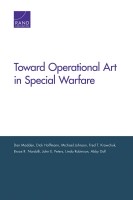| 来源类型 | Research Reports
|
| 规范类型 | 报告
|
| DOI | https://doi.org/10.7249/RR779
|
| ISBN | 9780833087638
|
| 来源ID | RR-779-A
|
| Toward Operational Art in Special Warfare |
| Dan Madden; Dick Hoffmann; Michael Johnson; Fred Krawchuk; Bruce R. Nardulli; John E. Peters; Linda Robinson; Abby Doll
|
| 发表日期 | 2016
|
| 出版年 | 2016
|
| 页码 | 186
|
| 语种 | 英语
|
| 结论 |
Special Warfare Campaigns Call on Capabilities Across the Joint Force and U.S. Government to Advance U.S. Policy Objectives- Special warfare campaigns have a distinctive focus that could include stabilizing or destabilizing a targeted regime, employing local partners as the main campaign effort, and maintaining a small U.S. footprint in the targeted country. They also may employ political warfare methods to mobilize, neutralize, or integrate individuals or groups from the tactical to the strategic levels.
- Special warfare campaigns are typically of long duration and may require extensive preparatory work better measured in months (or years) than in days.
- Special warfare campaigns require intensive interagency cooperation. For example, the U.S. Department of Defense may be subordinate to the U.S. Department of State or the Central Intelligence Agency.
There Is a Need to Adapt Conventional Operational Art to the Unique Characteristics of Special Warfare- Commanders and planners must be proficient in all relevant forms of operational art, including special warfare, if they are to design successful campaigns across the full range of military operations in modern conflicts.
- Keeping special warfare within the joint operational art construct will enable collaboration between special operations and conventional forces; the principles of operational art connect tactical actions and strategic objectives by supporting the design of successful campaigns.
- Special warfare makes a unique contribution to operational art in terms of the mobilization of partners' strategic and operational centers of gravity, and the neutralization or integration of the enemy's, in the human domain.
|
| 摘要 |
- There should be a joint effort to educate special warfare campaign planners as a way of strengthening special warfare strategic and operational planning capabilities. At the same time, because special warfare campaigns are inherently joint efforts, the special warfare community should help joint organizations develop a special warfare planning culture.
- Special warfare commanders and planners should help policymakers explore the implications of particular strategic objectives. Policymakers, in turn, should strive to provide clear policy guidance to inform the development of campaign plans.
- The special operations community should consider establishing a general officer–level operational headquarters element as a way to remedy the current ad hoc command-and-control architecture that has inhibited special warfare commanders' ability to participate in theater-level planning.
|
| 主题 | Civil-Military Relations
; Counterinsurgency
; Joint Operations
; Low-Intensity Conflict
; Peacekeeping and Stability Operations
; Special Operations Forces
; United States Army
|
| URL | https://www.rand.org/pubs/research_reports/RR779.html
|
| 来源智库 | RAND Corporation (United States)
|
| 引用统计 |
|
| 资源类型 | 智库出版物
|
| 条目标识符 | http://119.78.100.153/handle/2XGU8XDN/108233
|
推荐引用方式
GB/T 7714 |
Dan Madden,Dick Hoffmann,Michael Johnson,et al. Toward Operational Art in Special Warfare. 2016.
|
|
文件名:
|
x1495316216906.jpg
|
|
格式:
|
JPEG
|

|
文件名:
|
RAND_RR779.pdf
|
|
格式:
|
Adobe PDF
|
除非特别说明,本系统中所有内容都受版权保护,并保留所有权利。